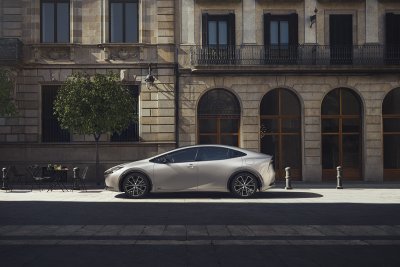The new, fifth-generation Toyota Prius prioritizes style and performance alongside efficiency. That was a major change for the company that for the four previous generations had only been focused on the most efficient travel possible, which was traditionally linked to gas mileage.
"There's an interesting background that is not generally understood by the public. We don't actually build hybrids to be fuel efficient," Paul Williamsen, product education manager, Lexus College told Newsweek. "That is not an objective of the engineers. What we build are hybrids that have the lowest possible tailpipe emissions. We make a fuel-efficient engine and then we use it under the fewest possible conditions."
Toyota still does that, but what has changed is the messaging.
The launch of the new Prius hybrid and Prius Prime plug-in hybrid electric vehicle (PHEV) is the first time Toyota wholly switched up its message on the model line.






The first-generation Prius premiered in Japan in 1997 at a time when few knew what hybrids were. In 2000 it went global, becoming the world's first mass-produced gasoline-electric hybrid car, and came to the U.S. with a retail price of just $19,995.
In the era of the Y2K panic, NSYNC popularity and the dot-com boom, Toyota had to educate buyers. The Prius didn't need to be plugged in to work. The company developed a dialogue with interested early adopters resulting in a pool of over 40,000 potential buyers that were given early access to the Prius microsite and its special-order feature.
Before it arrived in showrooms on June 30, 2000, Toyota already sold 1,800 Prius vehicles via online requests (another pioneering idea).
A few years after, celebrities were driving the second-generation Prius throughout Los Angeles and into paparazzi and press photos
"We got guys like Jeff Goldblum and Ed Begley Jr. We took over media events and things in Hollywood with a green carpet where people who showed up in a Prius could go to a special lane and valet. And some of those early adopters really helped to move it along," said Williamsen.
It took until May 2008 to sell 1 million Prius vehicles worldwide, right before the third generation debuted. Toyota moved production of the new Prius to the United States at that time and focused its marketing efforts, on billing the Prius as an "Eco-Icon", focusing solely on efficiency.
It was the first Prius to get an official Environmental Protection Agency-estimated fuel mileage rating of 50 miles per gallon (mpg) combined. Power went up but zero-to-60 mile per hour time clocked in at just under 10 seconds.
It received a slight exterior redesign, keeping that recognizable but quirky look. But Toyota's CEO was about to institute a major change at the company that would affect the Prius.
"I think it was about 10 years ago, Akio Toyoda put out an edict that he was really pushing the entire portfolio for no more boring cars. And this is a slow evolution. These platforms take time to evolve in terms of the product cadence, but this would be the latest evolution of that, moving away from a very utilitarian car to something that would elicit some passion from a whole slew of buyers," Tom Kretschmann, senior product technology education planner at Toyota told Newsweek.
Because of that, by the time the fourth generation was introduced for the 2016 model year, Toyota was starting to turn the corner. The Prius had fresh, sporty touches from the car (more power and a better suspension) to its commercials. A Super Bowl ad in 2016 had the Prius as a bank robber getaway car with the driver proclaiming, "it's pretty fast." However, it didn't completely shed its image with the bad guys only escaping when the police cars started running out of gas.

In its latest generation, Toyota has made the Prius all in on the things it was never known for: style and speed. Power went up again to 194 horsepower (hp) on the standard model and 220 on the Prius Prime. The overall design is a complete departure from everything in the Prius's past, but is the general, slippery shape of the previous vehicles.
"Up until the fifth generation, the main focus was efficiency. The new focus style and then performance on the Prius and performance then style on the Prius Prime. And then we're picking up on the efficiency from there. So, the goal is to bring in a new audience," Thomas Sondej, senior planner for Toyota Product Education told Newsweek.
"Obviously, we want to retain and keep the current loyalists excited and give them a new driving experience with Prius. But we also wanted to bring in a new, younger audience with the styling and fun-to-drive factor. That was the goal with the redesign," he said.
The success of the messaging remains to be seen. So far in the first quarter Toyota has moved half as many Prius vehicles as last year at the same time. However, the 40-mile all-electric range Prius Prime goes on sale in May giving more range to one of the most recognizable hybrid nameplates in the world.
Toyota also explained that "due to the complete model changeover there was a ramp down period of the previous model resulting in reduced Prius sales for the first quarter of 2023. Second quarter Prius sales volume is expected to be at normal levels comparable to the second quarter of 2022."
Uncommon Knowledge
Newsweek is committed to challenging conventional wisdom and finding connections in the search for common ground.
Newsweek is committed to challenging conventional wisdom and finding connections in the search for common ground.
About the writer
Jake Lingeman is the Managing Editor for the Autos team at Newsweek. He has previously worked for Autoweek, The Detroit ... Read more





